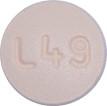Darifenacin Disease Interactions
There are 5 disease interactions with darifenacin.
Darifenacin (applies to darifenacin) gastric retention
Major Potential Hazard, Moderate plausibility. Applicable conditions: Gastrointestinal Obstruction, Ulcerative Colitis, Myasthenia Gravis, Constipation
Darifenacin is contraindicated in patients with gastric retention. Darifenacin, like other anticholinergic drugs, may decrease gastrointestinal motility and should be used with caution in patients with gastrointestinal obstructive disorders and conditions such as severe constipation, ulcerative colitis, and myasthenia gravis because of the risk of gastric retention.
Darifenacin (applies to darifenacin) glaucoma
Major Potential Hazard, Moderate plausibility. Applicable conditions: Glaucoma (Narrow Angle)
Darifenacin is contraindicated in patients with uncontrolled narrow-angle glaucoma. It is recommended to use darifenacin with caution in patients being treated for narrow-angle glaucoma and only where the potential benefits outweigh the risks.
Darifenacin (applies to darifenacin) urinary retention
Major Potential Hazard, Moderate plausibility.
Darifenacin is contraindicated in patients with urinary retention. Darifenacin is a competitive muscarinic receptor antagonist. It is recommended to use darifenacin with caution in patients with clinically significant bladder outflow obstruction because of the risk of urinary retention.
Darifenacin (applies to darifenacin) CNS effects
Moderate Potential Hazard, Moderate plausibility. Applicable conditions: Headache, Altered Consciousness
Darifenacin is associated with anticholinergic central nervous system (CNS) effects. Patients should be monitored for signs of anticholinergic CNS effects, particularly after the initiation of treatment or if the dose is increased. It is recommended to reduce the dose or discontinue treatment if patients experience anticholinergic CNS effects. Care should be exercised when prescribing this agent to patients presenting headache, confusion, hallucinations, or somnolence as these might worsen with the use of darifenacin.
Darifenacin (applies to darifenacin) liver disease
Moderate Potential Hazard, Moderate plausibility.
Darifenacin is extensively metabolized by the liver following oral dosing. The daily dose of darifenacin should not exceed 7.5 mg for patients with moderate hepatic impairment (Child-Pugh B). Darifenacin has not been studied in patients with severe hepatic impairment (Child-Pugh C) and therefore is not recommended for use in this patient population. No dose adjustment is recommended for patients with mild hepatic impairment (Child-Pugh A).
Switch to professional interaction data
Darifenacin drug interactions
There are 430 drug interactions with darifenacin.
Darifenacin alcohol/food interactions
There is 1 alcohol/food interaction with darifenacin.
More about darifenacin
- darifenacin consumer information
- Check interactions
- Compare alternatives
- Pricing & coupons
- Reviews (26)
- Drug images
- Side effects
- Dosage information
- During pregnancy
- Drug class: urinary antispasmodics
- En español
Related treatment guides
Drug Interaction Classification
| Highly clinically significant. Avoid combinations; the risk of the interaction outweighs the benefit. | |
| Moderately clinically significant. Usually avoid combinations; use it only under special circumstances. | |
| Minimally clinically significant. Minimize risk; assess risk and consider an alternative drug, take steps to circumvent the interaction risk and/or institute a monitoring plan. | |
| No interaction information available. |
See also:
Further information
Always consult your healthcare provider to ensure the information displayed on this page applies to your personal circumstances.


